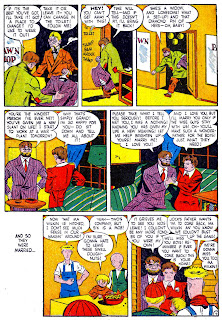Crazy was an attempt from Atlas Comics to lure some of the readers who were buying
Mad into parting with their dimes. Any
Mad loyalist would immediately see the attempt fell short. But even if it sounds as if I'm dismissing it, I actually like this comic with its frenetic energy and lunacy popping out of every panel. I like the sexy pin-up art of Al Hartley, who later went on to Archie and then to Spire Christian Comics; I like Bill Everett's funny Frankenstein, and Joe Maneely's artwork is, as always, superb. Ed Winiarski was a comic book journeyman, and Davy Berg later became a
Mad-man. What
Crazy didn't have was
Mad creator/writer/editor Harvey Kurtzman, and it makes all the difference. There was
Mad and then there was everyone else. It didn't make the imitators bad comic books, and
Crazy is entertaining in its own crazy way, but in my opinion no
Mad imitator ever reached the heights to which Kurtzman had taken
Mad. (See more in my review of John Benson's
The Sincerest Form of Parody, below the scans.)
Here's
Crazy #1 (1953):
************
John Benson’s book,
The Sincerest Form of Parody, is an excellent example of an overview (with examples) of a less-than-excellent subject. To wit (ho-ho), it is a book about all of them furshlugginer imitations of
Mad comics that popped up in the wake of
Mad’s success.
Benson, whom I admire as a comics historian,* obviously researched his subject matter. It appears that he read all of the
Mad imitators of that period. The book reproduces a couple of dozen stories, some better than others, but none up to the high standards set by Harvey Kurtzman and
Mad.
There just weren’t any other talents like Kurtzman out there at the time. There were writers who could write funny, and artists who could draw funny, but they couldn’t write and draw Kurtzman-funny. Even if the artists were technically good, they just didn’t come up to the level set by Kurtzman’s inspired cadre of cartoonists, artists like Elder, Wood, and Davis. At the time, they were the holy trinity of humor.
In my opinion, the best
Mad imitations are what you see above you, the
Mad-like comics from Atlas, and Harvey Comics’ short-lived
Flip, with the sharp Davis-like drawing by Howard Nostrand. EC Comics’ own in-house imitation,
Panic, had some gems like Wood’s “African Scream,” shown in
Pappy’s #871 or Elder’s “The Lady Or the Tiger,” the latter reproduced in Benson’s book. But same publisher or not,
Panic was still a
Mad imitator.
If Kurtzman worried at all about posterity, his name or his stories being remembered, he need not have been concerned. Kurtzman is one of the comic book geniuses, and they were rare, so we remember him. Reprints over the years have kept the twenty-three issues of
Mad comics available to fans in various print formats, even two digital versions. The imitations just don’t get that kind of treatment, so
The Sincerest Form of Parody makes some of the better imitators (“better” being subjective) available for the first time since their original publication almost sixty years ago.
I recommend
The Sincerest Form of Parody with a qualification. The stories can be more bizarre than laugh-out-loud funny, and oftentimes (which happens with
Mad, also) the satirical references are obscured by the half dozen decades between their first appearance and this book. Production is top notch, and the reproduction from the original four-color comic books is excellent.
It’s available from Amazon.com or your favorite bookseller. If your local comic shop has it or will order it for you, that’s even better.
The Sincerest Form of Parody by John Benson with introduction by Jay Lynch. Fantagraphics Book, 2011, trade paperback, 192 pages, 7 ¼” x 10”. $24.99 suggested retail.
*Benson also wrote
Romance Without Tears, and
Confessions, Romances, Secrets and Temptations, about the love comics of St. John publishing and writer Dana Dutch.
































































